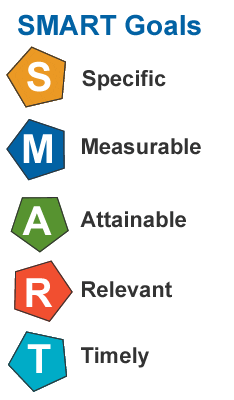 Do you have someone new on your team who is learning inbound marketing? If so, this post is for them!
Do you have someone new on your team who is learning inbound marketing? If so, this post is for them!
Proper training is vital to ensuring that your inbound marketing campaign is a success. The problem? Who has time? Well, we do. And we are breaking down the inbound marketing essentials into bite-sized pieces to provide your inbound marketing newbie with all the necessary data they need to become inbound marketing experts.
Creating goals is ultimately the way we measure and document our success as marketers. At Alaniz Marketing we utilize SMART goals for inbound marketing success.
SMART is a mnemonic guide to use when you’re setting goals for inbound marketing. The letters remind us to make sure our goals are specific, measurable, attainable, relevant, and timely. According to Wikipedia, the first known use of the term was in the November 1981 issue of Management Review by Gorge Doran.
Let’s look at each attribute of a SMART goal a bit more closely and how it pertains to inbound.
Your goal should be specific
A specific goal has a much greater chance of being accomplished than a general goal. To set a specific goal you must answer the four “W’s”:
- Who is needed to make it happen?
- What do I want to accomplish?
- When is it going to happen? Set a time frame.
- Why are you doing this? Establish the specific reasons, purpose or benefits of accomplishing the goal.
To begin, specific inbound marketing goals should focus on three things; increasing the number of visitors, leads and customers to your website. Having other specific goals is great, in fact you can have hundreds of other goals, but your first inbound marketing goal should always revolve around visits, leads and customers.
Your goal should be measurable
Now is the time to pick a number. Do you want 10 new visitors, leads, or customers per month? 100, or 1000? Whatever it is, this is the time to set your numerical goal. With a measurable goal in mind you can track your progress.
To effectively measure, ask questions such as:
- How much?
- How many?
- How will I know when it is accomplished?
Your goal should be attainable
If you set unachievable, unattainable goals you will be doomed from the onset. You need to be capable of achieving the goal you set. In order to set attainable goals you need to start with a benchmark.
Do you know your current visitor, lead and customers numbers?
If not, there are several ways to obtain this data. Google Analytics is a great way to see what you are currently pulling to your site each month.
If your company doesn’t currently track leads from your website, new visitors or customers and you have access to Hubspot, they offer a tool which gives you the benchmarks being achieved by companies that are comparable to yours. This gives you a starting point.
Tracking your own current visits, leads, and customers and setting your goal from those numbers will give you the most accurate and attainable number for your goal.
Your goal should be relevant
Is it relevant to your ultimate vision? If you stick to the suggestions above and focus on visitors, leads and customers, your goal will always be relevant to you ultimate vision.
Your goal should be timely
Set a specific time frame. Set monthly, quarterly and annual goals. With a specific time in mind there is a sense of urgency and something that you are working towards. Think of it this way. If you want to lose 10 lb., you wouldn’t just say…“Someday,” because then there’s no sense of having to get it done. But if you say, “by May 1st”, then you’ve set your unconscious mind into motion to begin working on the goal. Goals can be tweaked if they are being exceeded or you find that they are unattainable.
So let’s look at some SMART goals examples for marketing:
Increase conversions by 50% (currently at 300/mo and going to 450/month) by April 30th.
VISITS: Increase unique VISITS to the website by 20% (5000 per month to 6000 per month) by June 30, 2015.
LEADS: Increase LEADS by 30% (300 per month to 415 per month) by June 30, 2015.
CUSTOMERS: Increase new Customers by 100% (20 per month to 40 per month) by June 30, 2015.
Setting goals will save you time and ensure that you are focusing on the right things. The process of creating your SMART goals will assist you in understanding exactly what you want from your inbound marketing campaign and will increase visits to your website, leads for your sales team and bring in new customers. You can also track SMART goal performance with analytics tools like Databox.
Remember, nobody just wakes up successful one day. Success begins with SMART goals.




